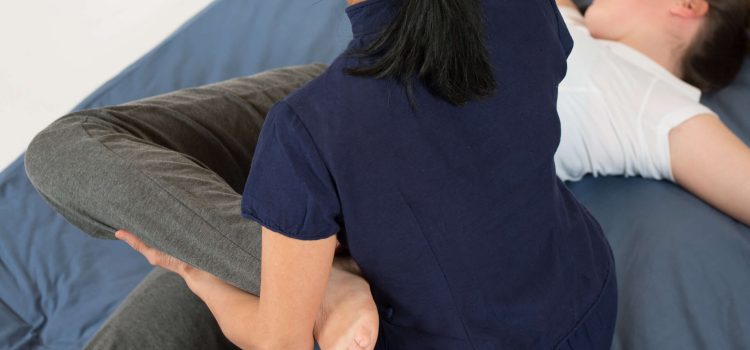
By applying pressure with their thumbs, elbows and feet, shiatsu therapists focus on the meridians and energy points (acupuncture) located beneath the skin or in the muscles, with the amount and type of pressure varying according to the person’s energy. Shiatsu is practiced within a context of overall personal development (physical, psychological and mental) and is performed over the clothes or directly on the skin.
Jump to section:
History
Shiatsu stems from manual therapies which have been practiced in China for thousands of years.
These therapies were brought to Japan in the 7th century and transformed into a simplified and refined approach, AN-MA. In the mid-19th century, they then evolved within a more medical context with a focus on “pressure.” The practice subsequently became known as SHI-ATSU (finger pressure). In 1955, Japan’s Ministry of Health officially recognized SHIATSU as a therapy in its own right.
Shiatsu borrows the idea that vital energy is split into two distinct but complementary currents, Yin (negative) and Yang (positive), from Chinese philosophy. Too much of either one creates an imbalance that the Western world calls illness.
Shiatsu incorporates the “five elements theory,” according to which five elements can be found in nature: Wood, Fire, Earth, Metal and Water. These elements correspond to general movements that can be observed in nature itself and in the human body ecosystem. They are also associated with specific organs in the human body (ex. Fire – heart), emotions (ex. Water – fear) and our environment (ex. Wood – spring).
These principles of Chinese philosophy are useful in order to understand how shiatsu is applied.
Applications and Effects
Our bodies are communication networks in which energy channels, or meridians, serve as a link between the organs. There are 12 main meridians, each named after the organ or body function that it connects to the vital energy current. There are ascending Yin meridians and descending Yang meridians.
In shiatsu, energy is circulated through the meridians by applying appropriate pressure (ranging from gentle to intense) along the meridians, including the tsubos. Tsubos are points located on the body, most of them along the meridians. Some are located outside of the meridians; these tender spots are known as ASHI points, which correspond to specific locations under the skin and can be found at various depths in the body and muscular system. They are located wherever the nerve endings are particularly sensitive to pain when the vital energy is blocked.
Shiatsu therapists check their clients’ energy imbalances using at least one of the following energy-reading methods:
- Hara zones
- Back reflex zones
- “Bo” points
- “Yu” points
- Oriental diagnosis
In the Eastern view, illness is caused by an energy imbalance, when energy has trouble circulating through the meridians and related organs.
Shiatsu therapists balance the energy in the meridians by stimulating or dispersing the energy and using the tsubos. They choose the zones and meridian segments that they will work on. Pressure can be gentle and pleasant or strong and intense, and good Shiatsu therapists will check with their clients to ensure that the pressure is bearable as well as beneficial.
Indications and Contraindications
Shiatsu is generally preventative and aims to maintain optimal health.
Below are some examples:
- Shiatsu can reduce or relieve day-to-day ailments such as stress, anxiety, fatigue, headaches, back pain, insomnia, etc.
- It improves breathing and relieves muscle tension
- It relaxes and soothes the recipient
- It increases the body’s resistance to damage
- It helps restore the body’s self-healing processes and improves its resistance to infection and illness
- A shiatsu session leads to more restful sleep
- It rejuvenates the elderly
- It is recommended for constipation, headaches and sciatic nerve disorders
- It is also very beneficial for menstrual problems and related ailments
Shiatsu can be used to comfort and calm individuals who are experiencing pain or distress. Its therapeutic benefits also increase with regular sessions.
Shiatsu is suitable for everyone.
During the health assessment, the therapist will check whether the client has any health-related contraindications. For example, it is important to let your therapist know if you have recently undergone major surgery or if you have osteoporosis, a contagious skin infection or a fever.
Conduct of a Session
Shiatsu is traditionally performed on a mat on the floor, or sometimes on a low massage table. Recipients remain clothed and practitioners do not use oil. They apply pressure to the body, including strokes designed to loosen the joints.
Shiatsu practitioners or therapists consult with their clients to determine their needs, explain how shiatsu can help them and describe what will happen during the shiatsu session. They then conduct a health assessment and check whether there are any contraindications to massage.
If the therapist identifies a Ki energy imbalance in the liver during the energy reading, he or she will work on that area in particular by applying an appropriate amount of pressure for the energy of the meridian connected to the liver. Don’t be surprised if the therapist works on your leg next, since the meridian passes through it!
Next, the therapist uses specific techniques to direct the energy. Pressure is applied to the body in a perpendicular direction during the expiratory phase of respiration, while the body is relaxed. In addition to pressure, the therapist uses stretches, joint mobilizations and other techniques that are often seen in other types of massage. The therapist proposes a treatment plan and suggests certain exercises to balance the client’s energy.

